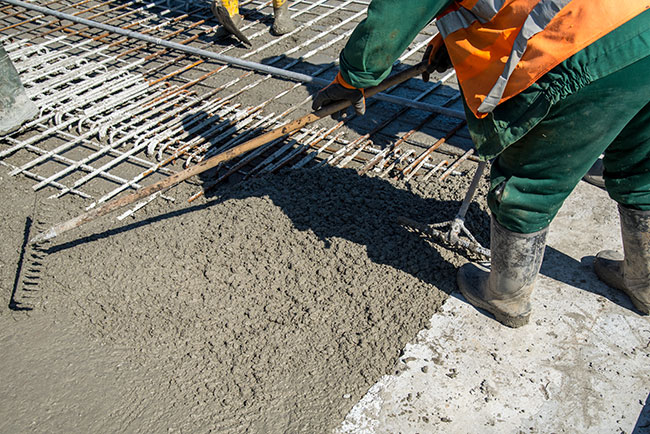
Features
Aggregates
Appointments
Profiles
For OSSGA, 2024 is full of opportunity
This year has potential to be very good for Ontario's aggregate industry, says Michael McSweeney.
April 16, 2024 By Mike Lacey
 It’s projected Ontario will need to produce an average of 190 million tonnes of aggregate a year to meet the demands of the province’s growing population. Photo: Getty Images
It’s projected Ontario will need to produce an average of 190 million tonnes of aggregate a year to meet the demands of the province’s growing population. Photo: Getty Images
The Ontario Stone, Sand and Gravel Association (OSSGA) has a new man at its helm.
Michael McSweeney took over as executive director in November of 2023, replacing Norm Cheesman who had guided the organization for nearly eight years.
McSweeney brings a wealth of experience to the role.

Michael McSweeney, the new executive director of the Ontario Stone, Sand & Gravel Association.
Most recently he was executive director of the Ontario Road Builders Association. Prior to that, he served for as president and CEO of the Cement Association of Canada. McSweeney has worked in the private and public sector for more than 35 years, which includes nearly a decade as a city and regional councillor in Ottawa.
Rock To Road recently spoke with McSweeney about the aggregate industry’s outlook for 2024, his background and his vision for OSSGA moving forward.
When you look at the challenges and opportunities across the industry, how would you describe the current state of Ontario’s aggregates sector heading into 2024?
McSweeney: You could say the aggregate industry is at a crossroads. All levels of government are spending unprecedented amounts of money in public infrastructure. They are spending money on social infrastructure — hospitals, schools and long-term care homes — on above ground infrastructure — roads and bridges — and on below ground infrastructure — wastewater treatment infrastructure and above and underground transit. It’s an unprecedented investment, but none of it can be built without aggregates. More roads and infrastructure mean that we need more aggregate. A lot more. It is estimated that to meet the challenges of Ontario’s growing population we will need an average of 190 million tonnes of aggregate a year.
However, while this demand is growing, the timeline to bring new aggregate sites into production is increasing. NIMBYism and the misinformation that is so prevalent about aggregate is the root cause of the problem. In 2024 and beyond, we need to pull out all of the stops and help educate and persuade Ontarians about the need for aggregate – and that close-to-market aggregate is the environmentally-smart solution to building Ontario’s infrastructure. This outreach will include active meetings with First Nation Communities, environmental groups and other decision-makers and influencers in our province.
Could you tell me about your past roles and experiences, and how this will inform your decisions and approach in your new position as executive director of OSSGA?
McSweeney: I bring with me a wealth of experience right across the supply chain. I was the CEO of the Cement Association of Canada for 15 years, as well as most recently the CEO of the Ontario Road Builders Association, so aggregate seemed the next logical place for me to land. You could say that I’ve done it backwards – I’m going down the supply chain to the raw material that makes it all happen, because without stone, sand or gravel, nothing gets built in Ontario.
The specific experience I bring to OSSGA is around sustainability and a vision for a net-zero industry by 2050. We have an engaged board and membership, and we will continue to map out a plan for the aggregate industry to address climate change and I’m very much looking forward to bringing my vision, experience and passion for the environment to the aggregate business.
When it comes to events, advocacy and organizational plans, what does 2024 have in store for OSSGA?
McSweeney: OSSGA is pleased to be hosting our conference and AGM in February. In 2024, we’re pleased to be launching our inaugural Queen’s Park Lobby Day, which will be held this spring. It is important to have a constant, consistent and co-ordinated presence at Queen’s Park along with a compelling story to tell legislators and civil servants. This presence will create opportunities for our members to showcase not only the importance of stone, sand and gravel to building Ontario but how the industry plays such an important role to the economy of virtually every riding in the province. It is also important for OSSGA to create stronger ties with municipal governments who are charged with developing Official Plans for their communities.
In addition to attending the Association of Municipalities of Ontario’s annual meeting, we look forward to sponsoring and hosting the mayors and councillors of the province in a reception in Ottawa, as well as visiting them in their cities and towns. To tell the story of aggregate, we need to be out speaking to the politicians and helping them work with their constituents to demonstrate the need for aggregates in all aspects of their daily lives.
I’ll be spending a lot my time with these communities explaining why aggregates are so important. But I will also try to understand their fears.
The reality is, we don’t have a choice where to locate our pits and quarries. We have to locate business where the Creator put the aggregate. But where we can have an impact is how we extract aggregate in a socially and community minded way. It’s a process of education and building relationships so that we can better understand what is at the root of people’s concerns.
With the Ontario government planning to build 1.5 million homes by 2031, what will the province’s aggregate industry need to do to meet this demand?
McSweeney: Each home in Ontario takes approximately 250 tonnes of aggregate to build, not including the aggregate needed to build all of the roads, transit, shopping malls, schools and other infrastructure to support the people who will live in those homes. So that’s likely close to a billion tonnes of aggregate to put that new infrastructure in place.
To transform all of that aggregate into the concrete, cement, bricks, glass, asphalt, subway lines and road bedding that we need – while being environmentally smart – it’s imperative that we embrace the use of close-to-market aggregate. That means reducing the lead time it takes to bring new pits and quarries online. We can always get aggregate further north, but should we be extracting aggregate and trucking it across dozens of municipalities further south?
Industries across Canada are facing difficulty in finding and retaining labour. What are the unique challenges Ontario’s aggregates sector faces on this front and what are some of the initiatives OSSGA has announced or is planning around this issue?
McSweeney: Working in the aggregate industry is a great career opportunity. A lot of people who work in the aggregate industry come from the community, so they are our ambassadors. They are the ones who should be talking about the benefits of employment in the aggregate sector. The biggest barrier we have as an industry is that opportunities in the sector are not well known. For that reason, OSSGA has been attending career fairs and working with sector partners to better showcase the career opportunities especially in the area of heavy equipment, mechanics and environmental scientists. We really encourage anyone who is interested to visit GravelFacts.ca where they can see a wide variety of career opportunities described by the people currently in those jobs. From plant operator to field worker, the opportunities are endless.
With the prevalence of both construction opportunities and labour issues, what role can emerging technologies, such as automation and artificial intelligence, play in the aggregate industry? Are there any other technological solutions you are excited about?
McSweeney: There are definitely sites in the United States that are starting to implement some automation with respect to loaders and trucks. That technology hasn’t made its way into Canada yet, but there’s no question it’s coming. With respect to artificial intelligence, there are many opportunities in the not-too-distant future. An obvious one is enhancing equipment performance by using sensors to monitor performance and then using AI to optimize the operation of that equipment. Augmented reality will play a crucial role in training and maintenance programs with workers using smart glasses to obtain real-time instructions. Predictive analytics will help better optimize production, schedules, anticipate equipment failures and make data-driven decisions for continuous improvement.
When looking beyond 2024, what are your long-range plans and goals for OSSGA?
McSweeney: It’s an exciting time. I would say our long-range plans and goals are focused on building relationships: with governments, First Nations, environmental groups and with Ontarians in general. OSSGA wants everyone to know the world is built with stone, sand and gravel, and that our members are here to do that in the most responsible way possible. We can’t build homes, hospitals and public transit without aggregates. We can’t build roads without aggregates. Aggregates are the fundamental foundation of our communities and Ontarians need to understand that better.
Print this page